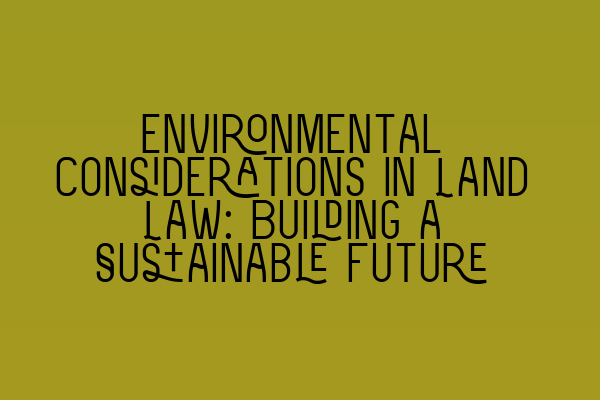Environmental Considerations in Land Law: Building a Sustainable Future
As our society becomes increasingly aware of the impact of human activities on the environment, it is crucial for us to prioritize sustainability in all aspects of our lives. One area where sustainability plays a vital role is in land law. The way we manage and develop land can have significant implications for our environment and the health of future generations.
In this blog post, we will explore the importance of considering environmental factors in land law and discuss how we can build a sustainable future through responsible land management and development.
1. Environmental Impact Assessments (EIA)
When it comes to major land development projects, an Environmental Impact Assessment (EIA) plays a crucial role in identifying and mitigating potential environmental impacts. An EIA helps ensure that the development is compatible with the surrounding environment, and measures are in place to protect natural resources and habitats. It assesses factors such as air and water quality, noise pollution, and biodiversity. By conducting EIAs, we can make informed decisions that will minimize harm to the environment.
2. Conservation and Biodiversity
The preservation of wildlife and ecological systems is an essential aspect of sustainable land management. Incorporating conservation measures into land law helps protect biodiversity and contributes to the overall health of ecosystems. This includes identifying and designating protected areas, creating green spaces, and implementing strategies to restore and enhance natural habitats. By prioritizing conservation, we can safeguard our natural heritage for future generations.
3. Sustainable Development
Sustainable development is the cornerstone of responsible land management. It involves balancing economic growth with environmental protection and social well-being. In land law, sustainable development can be achieved through measures such as promoting energy-efficient buildings, implementing sustainable drainage systems to manage water runoff, and encouraging the use of renewable energy sources. Sustainable development practices not only minimize negative impacts but also provide long-term economic benefits and improve quality of life.
4. Climate Change Mitigation and Adaptation
As the effects of climate change become increasingly evident, it is crucial for land law to address this pressing issue. Mitigation strategies aim to reduce greenhouse gas emissions through measures such as promoting energy efficiency, sustainable transportation, and transitioning to low-carbon technologies. Adaptation strategies, on the other hand, focus on building resilience to climate change impacts, such as rising sea levels and extreme weather events. Through comprehensive climate change strategies integrated into land law, we can create a more sustainable and resilient future.
5. Public Participation and Education
Engaging the public in decision-making processes regarding land use and development is a fundamental aspect of sustainable land law. By giving people a voice in these matters, we can ensure that their concerns and values are taken into account. Public participation also fosters awareness and understanding of environmental issues, encouraging individuals and communities to make sustainable choices in their own lives. Education and awareness campaigns further promote responsible land management and empower individuals to contribute to building a sustainable future.
In conclusion, environmental considerations are crucial in land law for creating a sustainable future. By conducting Environmental Impact Assessments, prioritizing conservation and biodiversity, promoting sustainable development practices, addressing climate change, and engaging the public, we can ensure responsible land management and development. It is our collective responsibility to protect the environment and leave a legacy of sustainability for generations to come.
Related Articles:
– SQE 1 Practice Exam Questions
– SQE 1 Practice Mocks FLK1 FLK2
– SQE 2 Preparation Courses
– SQE 1 Preparation Courses
– SRA SQE Exam Dates
